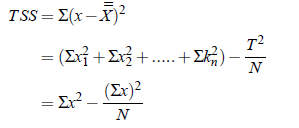SKEDSOFT
Techniques of One-way Analysis of Variance:
1. In One-way analysis of variance there are k samples, one from each of k normal populations with common variance σ 2 and means μ1,μ2, ...μn. The number of observations ni in samples may be equal or unequal i.e.
n1 n2 ....... nk = N
2. Linear Model:
xi j = μ αi ei j
Where xi j = observations i = 1,2, ....k, j = ni
μ = The general mean
ai = Effect of ith factor = mi−m
ei j = Effect of error or random term.
3. Null Hypothesis (H0) and Alternative Hypothesis (H1):
H0 : The means of the populations are equal i.e.
μ1 = μ2 = ....,= μk
H1: At least two of the means are not equal.
4. Computations:
(i) Calculate sum of observations in each sample and of all observations.
Sum of sample observations: 
Sum of the squares of the sample observations: 
(ii) Calculate correction factor CF = T2/N
Where T = Square of the sum of all the observations = 
N = Total number of observations
(iv) Calculate total sum of squares (TSS) by the formula

(v) Sum of squares between (SSB) samples by the formula

(vi) Calculate sum of squares within samples by the formula

Sum of squares may also be computed as SSW = TSS − SSB. Sum of squares within samples is also called Error Sum of Squares.